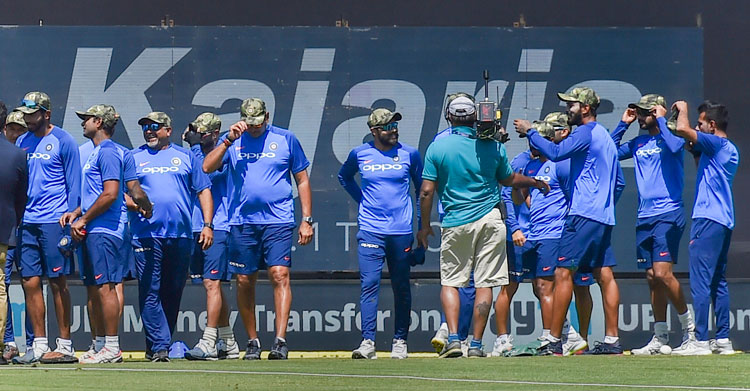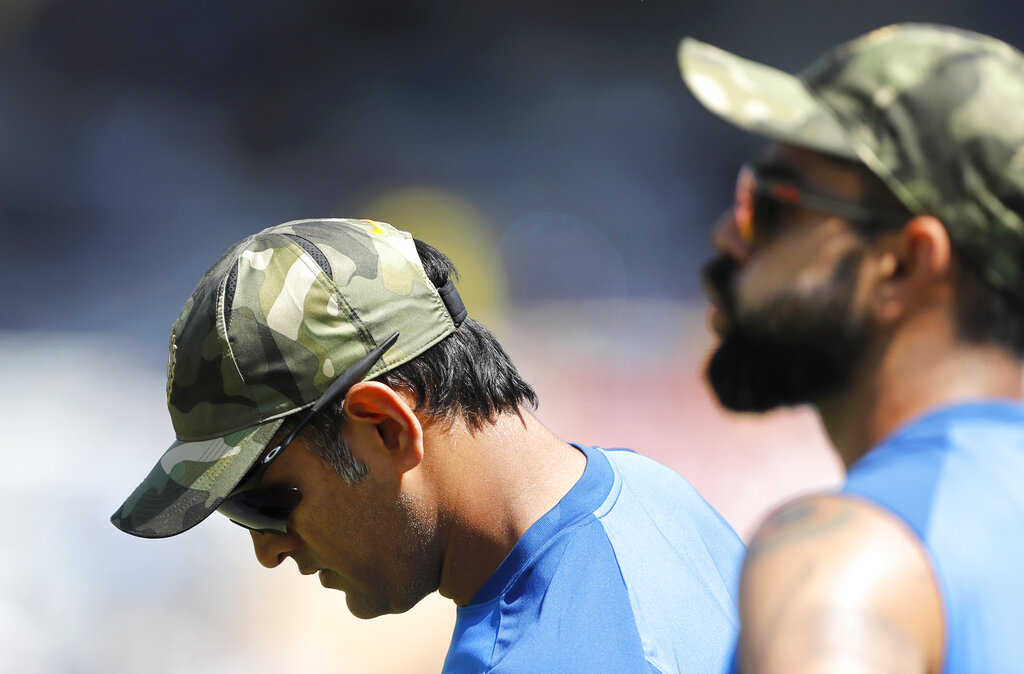For the third one-day international against the Australians, members of the Indian cricket team wore military camouflage caps in tribute to the CRPF and its sacrifices. Finely attuned to the temper of the time, Virat Kohli’s men chose to remind the millions watching that soldiers and sportsmen are both partisans of the Nation. If recent border skirmishing involved shooting without a war, cricket, in the pressure cooker of subcontinental competition, is war minus the shooting.
The cap wasn’t a spur-of-the-moment gesture; it had been a long time in the making. Newspapers reported that the captain and M.S. Dhoni had collaborated with Nike, the apparel sponsor of the Indian team, for six months to design the cap, well before Pulwama. It’s worth remembering here that Dhoni’s commitment to military livery is longstanding: he holds the rank of a lieutenant colonel in the Territorial Army and has been frequently photographed in military fatigues. It was appropriate that the setting chosen for the cap’s unveiling was Ranchi, his home town, where the pavilion in the cricket stadium is named after him. The sponsor deserves appreciation for making this patriotic commemoration a public-private partnership, a collaboration as it were, between Nike and the Nation.
Newspaper reports also indicated that this was not a one-off commemoration; these camouflage caps will be reused. Kohli’s team will play one home match every year in these caps to show their respect for the armed forces. This steadfast identification with the military is unprecedented in the history of Indian cricket. There is no record of teams led by Mansur Ali Khan Pataudi or Ajit Wadekar acknowledging the sacrifices of India’s soldiers in the aftermath of the Sino-Indian war of 1962, the Indo-Pak war of 1965 or the Indo-Pak war of 1971, all of which were much larger conflicts than the recent exchanges across the Line of Control.
This is not to impugn the patriotism of these captains or their teams but to draw our attention to the truth of the adage, ‘cometh the hour, cometh the man’. (Or men, since between Dhoni and Kohli, there is a double-headed quality to this ODI team.) Those were early years in the life of the republic with the Sixties, especially, being an embattled decade for the young nation. The flame of nationalism mightn’t have burned the oxyacetylene blue that it currently does. Cricket teams are expressions of the national mood and in an India where the national airline’s cabin staff are required to chant ‘Jai Hind!’ with feeling after every flight announcement, it’s inevitable that the current team will be more demonstratively nationalist than those gone by. Dhoni and Kohli have pioneered a pro-active patriotism and it’s very likely that the teams they create in their image will be manned by Pro-Active Patriots.
Viewed correctly, these camouflage caps are an opportunity to have a larger discussion about the design of India’s limited-overs uniforms. For too long, India has played in a nationalistically non-resonant blue. Blue doesn’t allow our cricketers to channel their inner PAP. What does blue signify? Nothing. Nothing, that is, apart from India’s cricketing tradition and what price ‘cricketing tradition’ compared to the colours of the nation? Take the Pakistanis: their uniform is their flag, complete with green-and-star. Why should the Indian team be arrayed in a colour that channels their nation less full-bloodedly than the uniforms of the Pakistanis?
Indian teams hereafter should wear tiranga topis. The effete aesthetes who think this will look luridly jingo are wrong. Sharply designed, a tri-coloured topi could look as hip as a Harlequin cap. Transferred to batting helmets, India’s colours would obviate the need to paste a tiny flag above the crest. When Kohli next celebrates a century, he’ll be able to kiss any part of the surface area of his helmet instead of puckering-up and aiming at a flag the size of a stamp. If a tri-coloured cap is deemed too gaudy, and if the BCCI wants to retain a vestige of blue, the Ashoka Chakra with its blue wheel and its twenty-four spokes could be mapped on to Indian caps and helmets.
It’s important not to stop with headgear. One of the defects of the camouflage cap idea was that each time India’s bowlers took it off to bowl, the concerted impact of an Indian XI paying patriotic homage was diluted. The really transformational task is to reinvent the uniform which can’t be doffed. To continue the flag theme, the colours of the uniform should be green and orange. But it’s important that they be aesthetically combined. Here, our inspiration should be the Australian strip which plays on that country’s favoured ‘green-and-gold’ theme. Australian uniforms, over the years, have been mainly yellow (‘gold’) with green being used only as an accent.
In exactly the same way, the Indian team’s limited-overs uniform ought to be overwhelmingly orange with green details (for the piping, for instance, or the sponsors name). It goes without saying that this would be an aesthetic and utilitarian choice, not a denominational one. Given the number of teams who favour green (the South Africans, for example, and the other lot), orange would be distinctive and unique. It would also give the Bharat Army a proper colour to get behind, instead of this alien, affect-less blue. Another refinement would be to replace the BCCI’s anonymous crest with the iconic image of Bharat Mata centred on a map of undivided India.
But given the rate at which change occurs in India, this lies some distance in the future and the World Cup is upon us. Given the shortage of time, Dhoni and Kohli should press the logic of their camouflage idea. It has been reported that the inspiration for the cap was Glenn McGrath’s cancer initiative where he hit upon the scheme of outfitting the Australian team in pink caps for commemorative Sydney Tests. The important point here is that when the Proteas followed McGrath’s example in the context of an ODI, they didn’t stop at pink caps; they went pink from top to toe. Taking its cue from the South Africans, the BCCI should inform the ICC that its team will wear full army fatigues for the World Cup. If the ICC has a problem with full dress camouflage, the BCCI (as a fallback measure) can offer to comply with the dress code so long as the Indian team can switch colours to Olive Green.
Scolds will point to India’s defeat in Ranchi and argue that to lose in militaresque uniform is to aggravate national humiliation. Fatigues aren’t for the faint-hearted (as Dhoni can tell us) and defeat is nothing to be afraid of. In the worst-case situation, if India-in-fauji-uniform were to lose to Pakistan in the World Cup, it would amount to metaphorically dying for the country. Why would that be a humiliation? In cricket (as in war), it’s not the winning that matters, it’s the taking part. The Balakot bombings taught the Nation an important lesson: it wasn’t the damage in the real world that was important, it was fact that India dared to think escalatory thoughts. In cricket and war in modern India, it’s the thought that counts.













